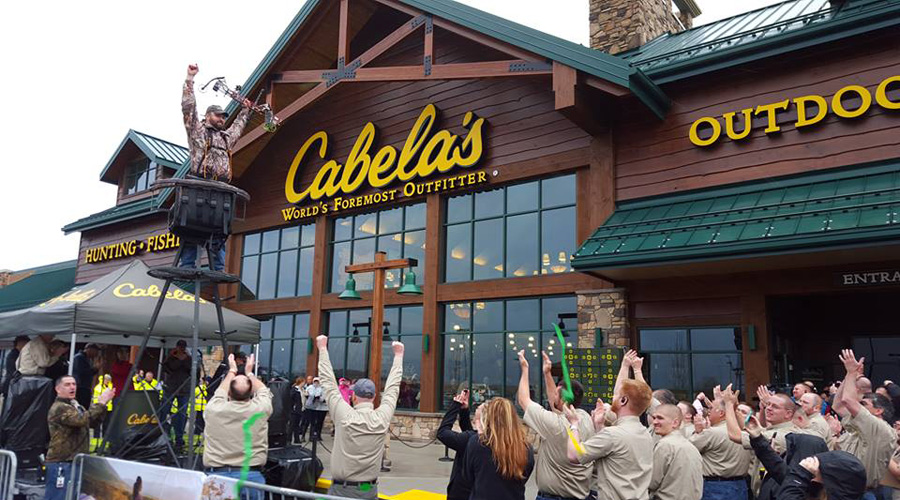Cabela’s not surprisingly saw earnings and sales decline in the first quarter as a result of an industry-wide downturn in firearms sales following the election of Donald Trump. But expense-containment efforts and healthy results from Cabela’s CLUB Visa program helped the retailer exceed Wall Street estimates
Cabela’s no longer holds a quarterly earnings conference call with analysts due to its pending merger with Bass Pro.
For the quarter, on a GAAP basis, total revenue decreased 3.4 percent to $834.9 million. Results were slightly less than Wall Street’s consensus sales of $856.3 million.
Revenue from retail store sales slid 3.9 percent to $542 million. Internet and catalog sales fell 12.6 percent to $136.1 million while financial services revenue increased 6.5 percent to $150 million. U.S. comparable-store sales declined 9.1 percent and consolidated comparable-store sales decreased 8.9 percent.
Net income slumped 16.7 percent to $19.1 million, or 28 cents a share. Adjusted to exclude non-recurring items, profits slipped 6.4 percent to $27.6 million, or 40 cents a share. Results exceeded Wall Street’s consensus target of 36 cents a share.
“While we were disappointed with our merchandise sales in the first quarter, we were very pleased with the excellent performance of our Cabela’s CLUB Visa program and our focus on expense management, which continued to provide meaningful contributions to profitability,” said Tommy Millner, Cabela’s CEO, in a statement. “Similar to broader retail industry trends, we continued to experience challenging traffic patterns in the first quarter. Our growth in average ticket was more than offset by continued decreases in transactions.”
The comp decline was attributed to several specific events. Firearms and ammunition have faced several headwinds including the election and the tough comparisons from the San Bernardino tragedy a year ago. Many firearms suppliers have indicated firearms sales had been running strong early on in anticipation of Hillary Clinton winning the election, but have since softened due to a fewer concerns about gun ownership restrictions under the Trump administration.
The home and gifts category was also challenged by difficult comparisons related to a significant spike in demand for specific items in the first quarter a year ago. While apparel categories comped negatively for the quarter, they have shown signs of improvement and were down less than the consolidated comp.
Merchandise gross margin decreased 80 basis points in the quarter to 31.4 percent. Sales discounts and promotional activity were responsible for approximately 70 basis points of the decrease, and the merchandise mix impact was approximately 10 basis points of the overall decrease for the quarter.
On a GAAP basis, SD&A expenses decreased $1.3 million to $327.9 million. On a non-GAAP basis, SD&A expenses decreased $3.1 million to $318.6 million. Expense reductions were primarily related to efficiencies in labor and a decrease in certain marketing expenses.
“We continue to be very pleased with the results of our expense and process improvement initiatives,” Millner said. “We are particularly encouraged by the sustainable impact of these initiatives from their implementation in 2015 through the first quarter.”
Impairment and restructuring charges amounted to $2.4 million in the latest quarter versus $2.97 million in the same period a year ago. Of the charge in the latest quarter, $1.5 million reflected severance agreements and termination benefits related to its corporate restructuring and staff reductions. The remaining $904,000 stemmed from impairment losses on other property.
The Cabela’s CLUB Visa program saw an increase of 2.4 percent in the average number of active credit card accounts along with growth in average balance per active credit card account of 8.3 percent. The average balance of credit card loans grew 11 percent to approximately $5.4 billion versus the year-ago quarter. Net charge-offs were 3.18 percent.
First-quarter Financial Services revenue increased 6.5 percent, primarily driven by increases in interest and fee income, largely offset by increases in the provision for loan losses as well as interest expense. During the quarter, the allowance for loan losses was reduced by $6.2 million as compared to a reduction of $1.2 million in the same quarter a year ago. For the quarter, the reduction in the allowance for loan losses was due to improvements in the roll rates for early stage delinquencies from the end of the fourth quarter of 2016 to the end of the first quarter of 2017.
On April 17, Cabela’s reached a deal with Synovus Financial Corp to help support the completion of its merger with Bass Pro. Synovus will acquire certain assets of Cabela’s financial division, World’s Foremost Bank, and then resell the credit card portfolio within the unit to Capital One Financial Corp.
As part of separate part of the original Cabela’s-Bass Pro merger, Capital One was expected to acquired World’s Foremost Bank. In late December, however, Capital One said it didn’t expect its part of the deal to be approved by the Treasury Department’s Office of the Comptroller of the Currency by October 3, the date after which either Bass Pro or Cabela’s could terminate their mega-merger. Synovus said it will receive $75 million in consideration from Cabela’s and Capital One.
On April 17, Cabela’s also said it agreed to reduce the price of its Bass Pro deal to $61.50 per share, lower than the originally agreed upon $65.50-per-share price. Under the revised terms, Bass Pro will pay about $5 billion for Cabela’s, down from $5.5 billion under the agreement first set on October 3, 2016. Cabela’s gave no reason for the lower price but it was attributed to the Synovus deal and the downturn in firearms sales.
Cabela’s expects the Bass Pro merger to close in the third quarter, as originally planned.
Photo courtesy Cabela’s
















